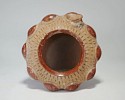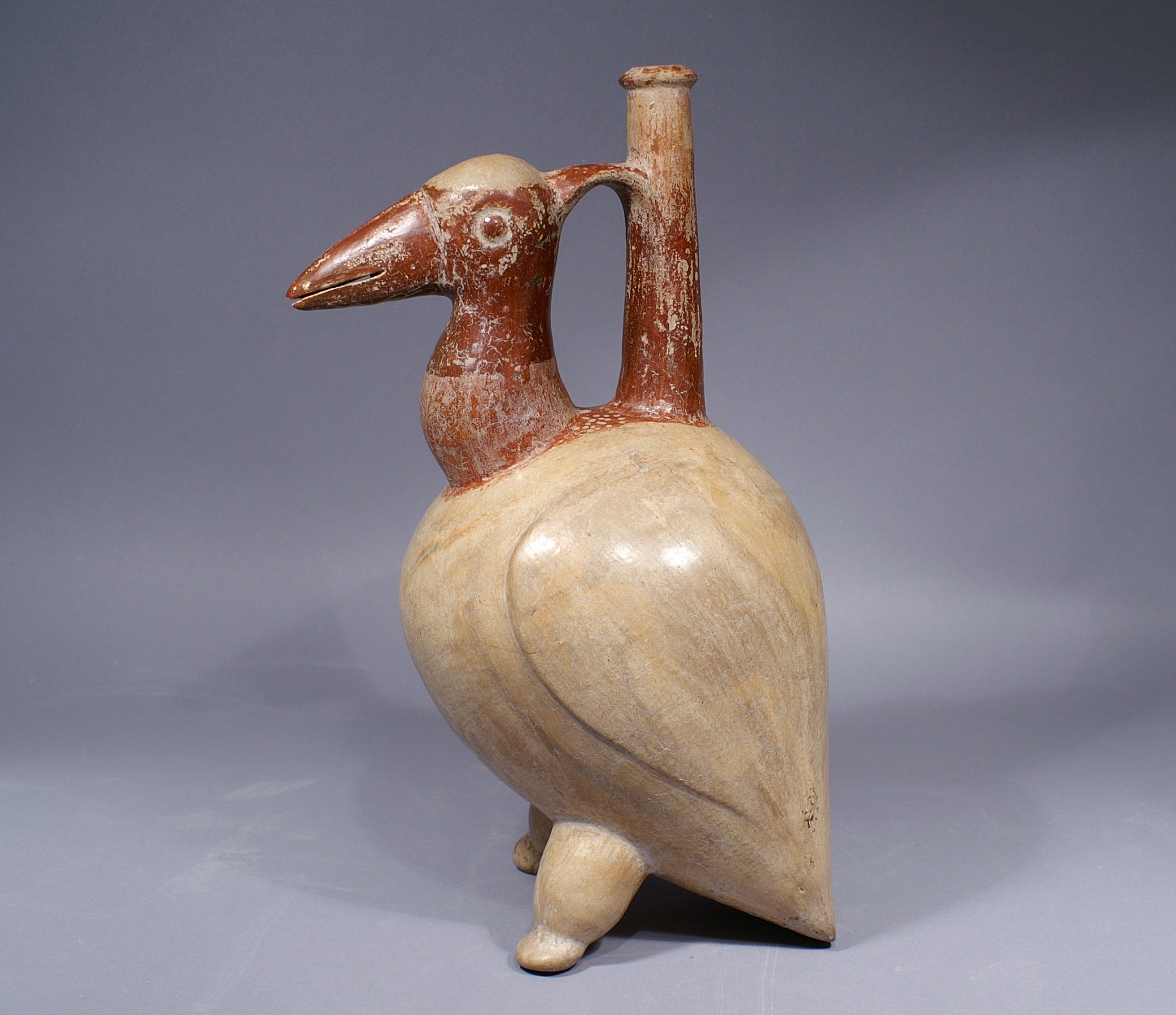



Ecuador, Chorrera Avian Effigy Spouted Vessel of a pelican
This effigy vessel represents a pelican decorated with red-brown slip on the head and neck over a buff body. The wings are softly modeled at the sides of the body, while the tail and quasi human feet support the vessel in a vertical position. Anthropomorphic effigy bottles with tall spouts are one of the hallmarks of Chorrera art, and may have been for high-status beverages for chiefs and shamans, probably alcoholic brews laced with hallucinogenic ingredients. They were also placed in tombs as offerings for the dead. The characteristic tall spout was almost certainly for the manipulation of liquid, and its slender height would have prevented spillage. A nearly identical vessel is published in Klein and Cevallos, eds., "Ecuador: The Secret Art of Precolumbian Ecuador" (2007: pl. 46). This pelican is slightly taller at 13 3/4" inches, and his head is turned 90 degrees, but the artist painted the head and feet in the same red-brown over a buff body with modeled wings.
Period: Ecuador, Chorrera, circa 500BC- AD500
Media: Ceramic
Dimensions: Height 12 1/2"
Price Upon Request
94295
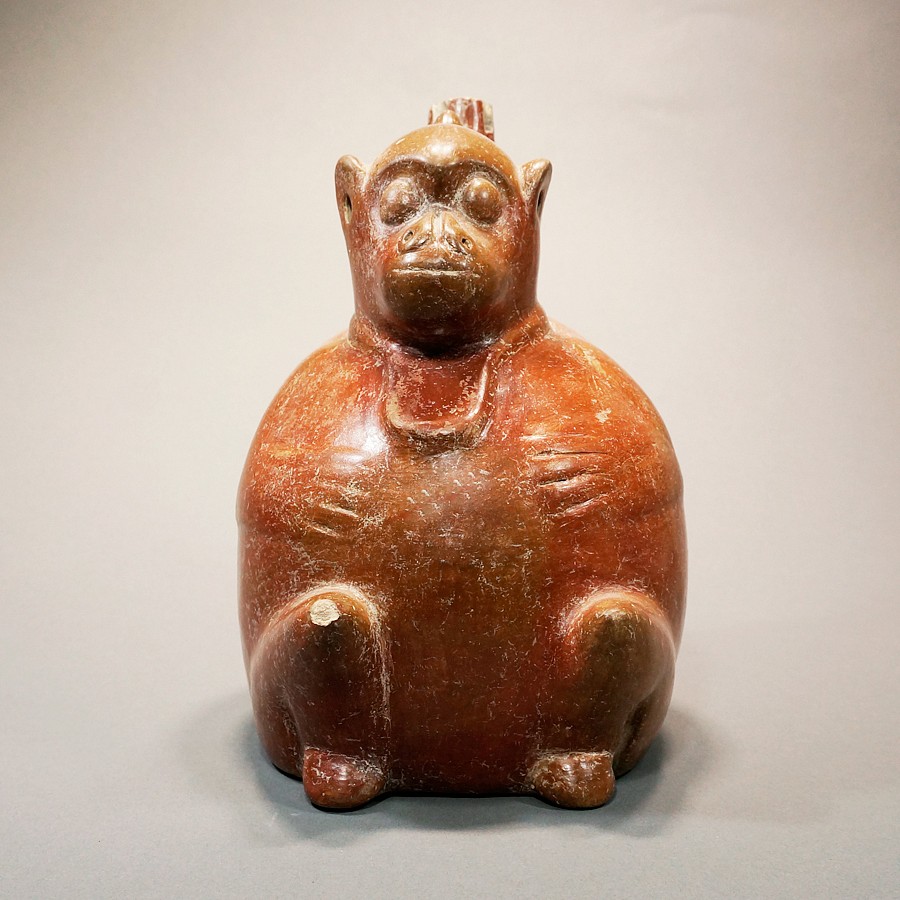
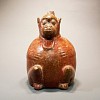
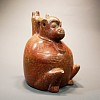
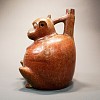
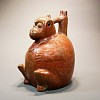
Ecuador, Chorrera Ceramic Baboon
Red brown bridge spout vessel of a baboon effigy with hands on chest and wearing a pendant. A similar example is illustrated in Valdez and Veintimilla, "Ameridian Signs: 5000 Years of Precolumbian Art in Ecuador" (1992: 54. The Chorrera culture, along with the Moche of Peru, were the only Andean societies to produce realistic ceramics at a very high level.
Period: Ecuador, Chorrera, 1000-500 BC
Media: Ceramic
Dimensions: Height 8.1/4"
$15,000
94008





Ecuador, Classic Chorrera Miniature Bowl
This vessel is decorated with a circular ring of heads. This style of vessel is known as a meeting themed vessel. One head faces forward and the others appear to be in trance. Dimensions: Height: 2 1/2" x Diameter: 4 1/2"
Period: Ecuador, Chorrera, 1500 - 300 BC
Media: Ceramic
Dimensions: "
Price Upon Request
M6016
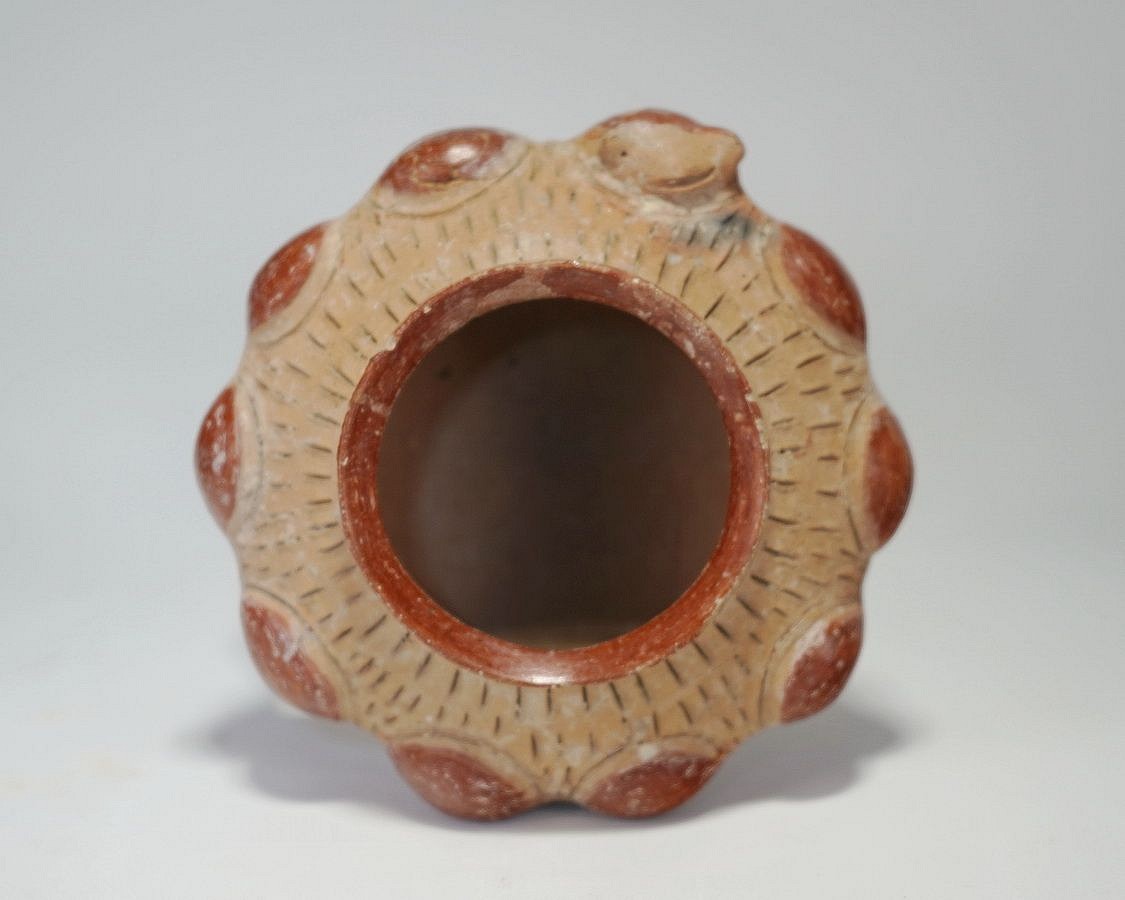





Ecuador, Classic Chorrera Miniature Bowl
This vessel is decorated with a circular ring of heads. This style of vessel is known as a meeting themed vessel. One head faces forward and the others appear to be in trance.
Media: Ceramic
Dimensions: Height: 2.5" x Diameter: 4.5"
$1,500
m6106
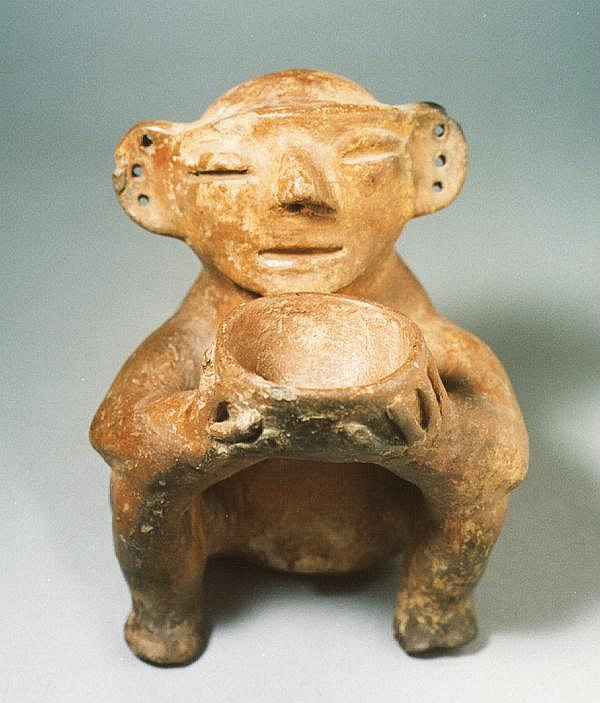
Ecuador, Ecuadorian Ceramic Seated Figure Holding a Bowl
This beautifully serene, meditative figure, perhaps a shaman, is seated in a restive position and offering a bowl. This bowl was perhaps used to inhale tobacco smoke or for drinking a ritual alcoholic or psychedelic libation. The historical record of the ancient Andes indicates shamanic use of mind-altering substances for religious rituals. A similar example is illustrated in
Meggers Evan’s Archeological Investigations on The Rio Napo.
Period: Ecuador, c. 1500 BC - AD 1500
Media: Ceramic
Price Upon Request
88203
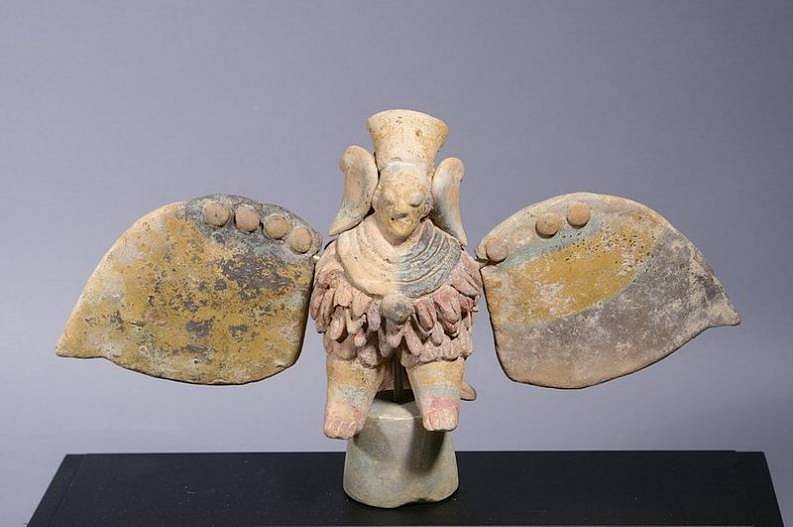



Ecuador, Guangala Bird Transformation Figure with detachable wings
This figure represents a shaman in a trance and envisioning himself turned into a bird that could fly to the otherworld to communicate with ancestors and spirits. He is wearing a feather poncho, detachable wings, and the back of the figure has a bird's rounded body and tail. The base elevates the figure off the ground as if he were actually flying. On the front of the figure there are traces of post-fire blue and yellow pigments.
Period: Ecuador, Guangala, circa 500BC-AD500
Media: Ceramic
Dimensions: Height: 5" x Width: 10" with wings
$4,500
M7090
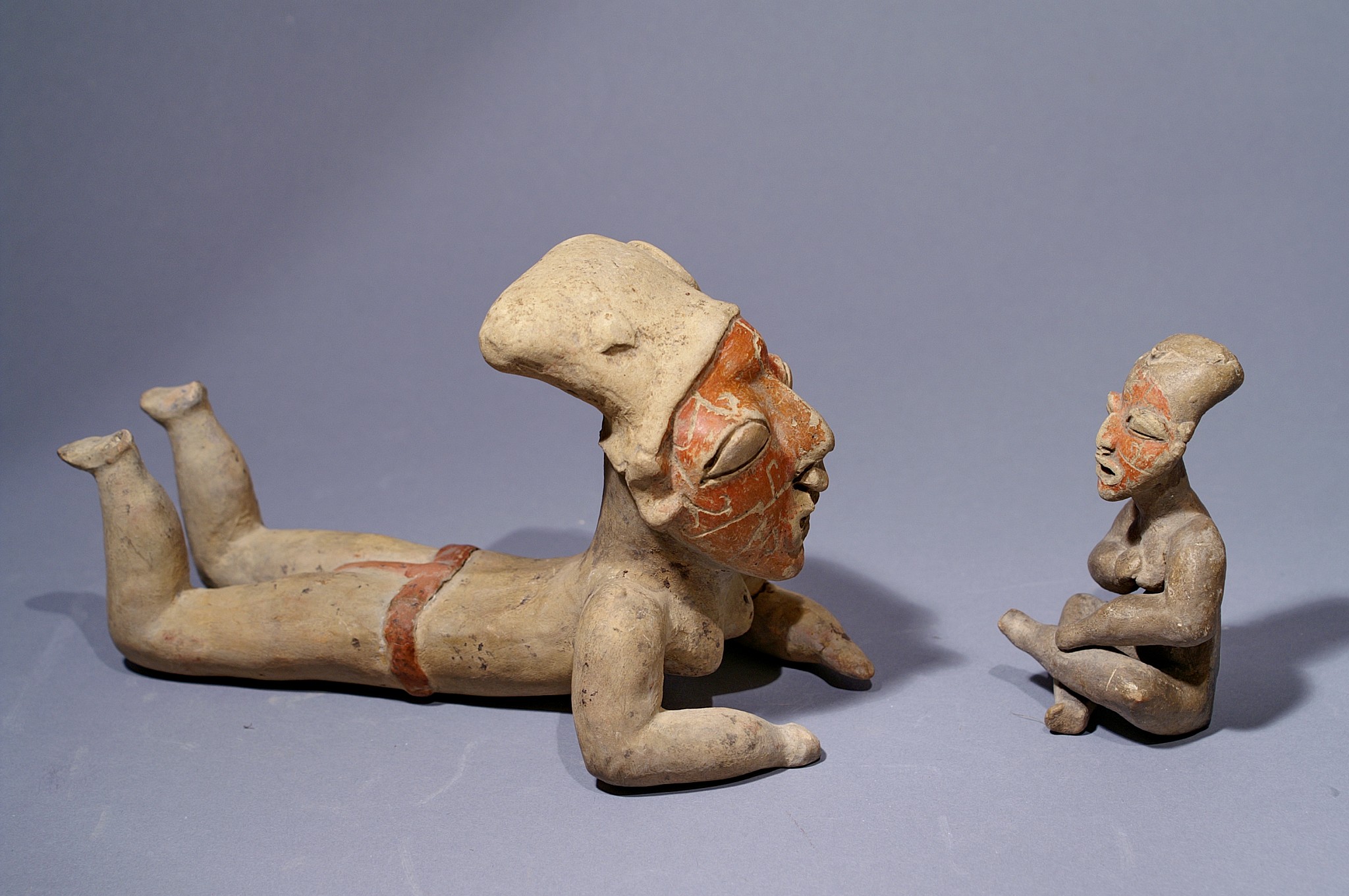




Ecuador, Guangala Pair of Female Figures, one lying down and one seated with hand to breast
The prone position of the larger female may have been borrowed from the neighboring Jamacoaque, but the facial incisions are typical of Guangala figures. The smaller seated female is similarly marked with carved facial designs. Guangala ceramics are unique in the northern coast for incising such markings on pottery figurines.
Period: Ecuador, Guangala, circa 500BC-AD500
Media: Ceramic
Dimensions: Height: 7 3/4" lying down, 3 3/4" seated
$12,000
M7089








Ecuador, Jama Qoaque Large Standing Queen Figure with Hands Held Out
The queen is wearing an elaborate hair style and with rich ornamentation. The figurine is standing in a hierarchical pose with traces of aquamarine pigment and a highly burnished short sleeve blouse. The arms are fully tattooed. a sign of high status. Besides the traditional ear and nose ornaments and libret. The queen is wearing a set of necklaces and has ornamented sleeves. This is one of the largest examples for the style as most of the other large examples are less than 40cm. A closely related figure with the same sleeve decoration is from the Cruz DePerone Collection, Quito and illustrated in Amerindian signs, fig 80.1. The condition is good with cracks in back of the neck in shoulders restored. All parts are original.
Period: Ecuador, Jama Coaque, Northern Manabi Region, 500 BC - AD 500
Media: Ceramic
Dimensions: Height 17.5"( 44cm) x Width 11.5"(29cm)
Price Upon Request
M9020






Ecuador, Jama-Coaque Ceramic Hand
This is a lovely small sculpture by itself, but the wrist has a drilled hole which suggests that it was originally part of an articulated ceramic figure.
Period: Ecuador, Jama- Coaque Culture, circa 350 BC-AD500
Media: Ceramic
Dimensions: Length: 6"
Price Upon Request
M7164
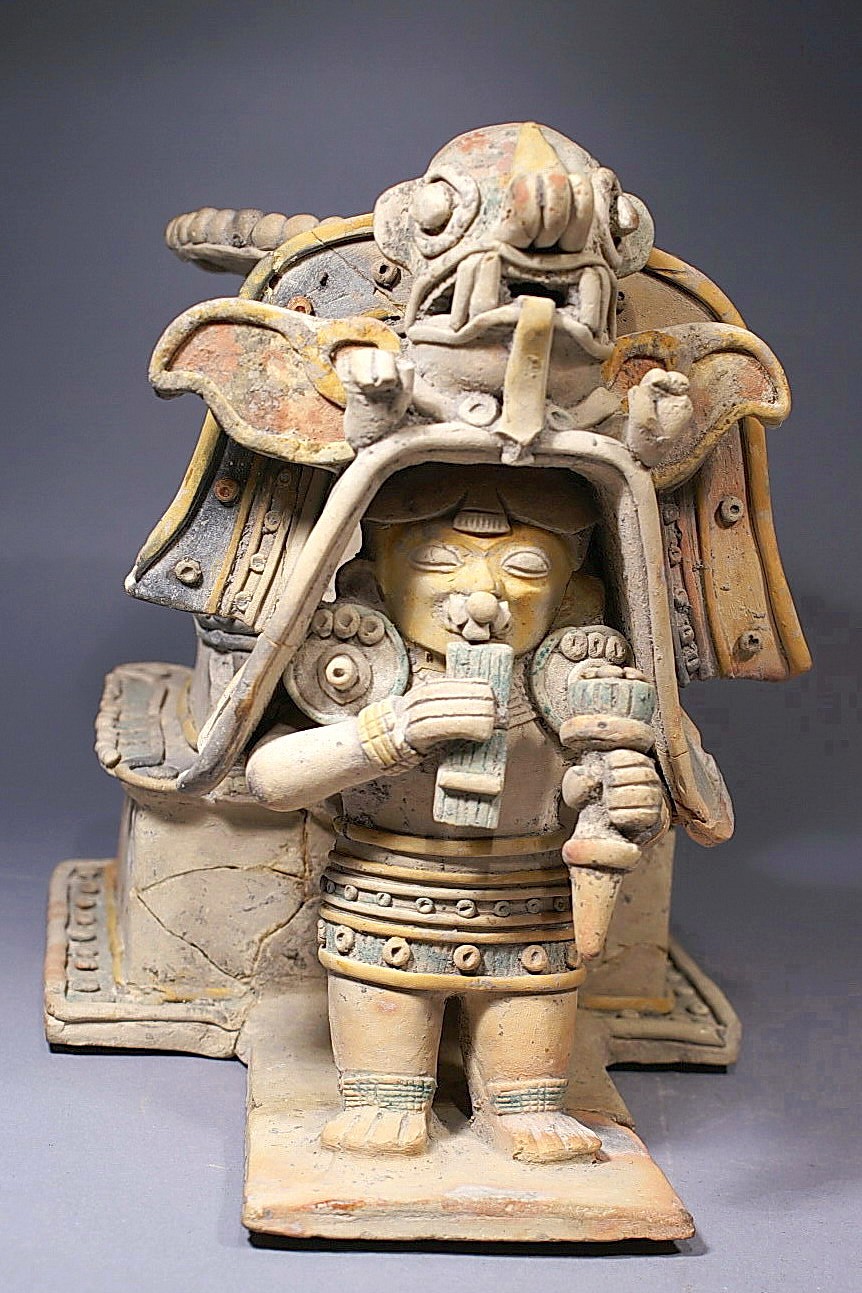




Ecuador, Jama-coaque Temple Scene with priest playing a flute
The priest is in full regalia with a spectacular headdress. He is playing a flute and shaking a rattle as if dancing in front of the temple behind him. This structure is an elaborate three tier temple with a high altar and delicate details. Traces of the original post-fire pigments are intact over the entire work in hues of blue, red and yellow. The only other temple from this early period is in the Banco Central (Quito, Ecuador). The authencity of the work has been confirmed through a series of X-ray scans by Dr. Marc Ghysels (Tomodensitometric Analysis 2007).
Period: Ecuador, Jamacoaque, circa 500 BC - AD 500
Media: Ceramic
Dimensions: Length 10.5" x Height 9"
$29,500
M6012

Ecuador, Jamacoaque Platform with priest and woman holding a small figure
This scene had a figure which was knocked off the platform and lost in antiquity. The female substitute included here represents the same type as the original. The Jamacoaque seem to have taken over centers occupied by the preceding Chorrera culture in the northern Guayas region of coastal Ecuador. The pottery of Jamacoaque potters focuses on the costumes and accessories of ritual and prestige worn by high-ranking men and women. There is precedent for this female figure in the Chorrera sequence, in which a woman appears to be holding a child, but on closer inspection, the baby is really a small man. Here, the small male wears a complete adult costume, including turban headdress, large necklace, bracelets and ligatures on his legs. He's a supernatural miniature rather than a human baby. There was a tradition in the nineteenth century among the inhabitants of Guayas of a female statue with a small figurine in her lap, kept in a temple on an island just off the coast (Valdez, "Ameridian Signs: 5.000 Years of Precolumbian Art in Ecuador," 1992: 68). Local natives visited the shrine bringing gold and silver body parts which they offered in order to cure the diseased or maimed. Such curing rites may be the scenario of the platform group presented here. The male is elaborately dressed as a chief or shaman with heavy jewelry, long earrings designed as fish, an array of birds on top of his headgear, and behind him, is his semicircular staff.
Period: Ecuador, Jamacoaque, circa 500 BC - AD 500
Media: Ceramic
Dimensions: Height: 6 3/4"
Price Upon Request
M7040
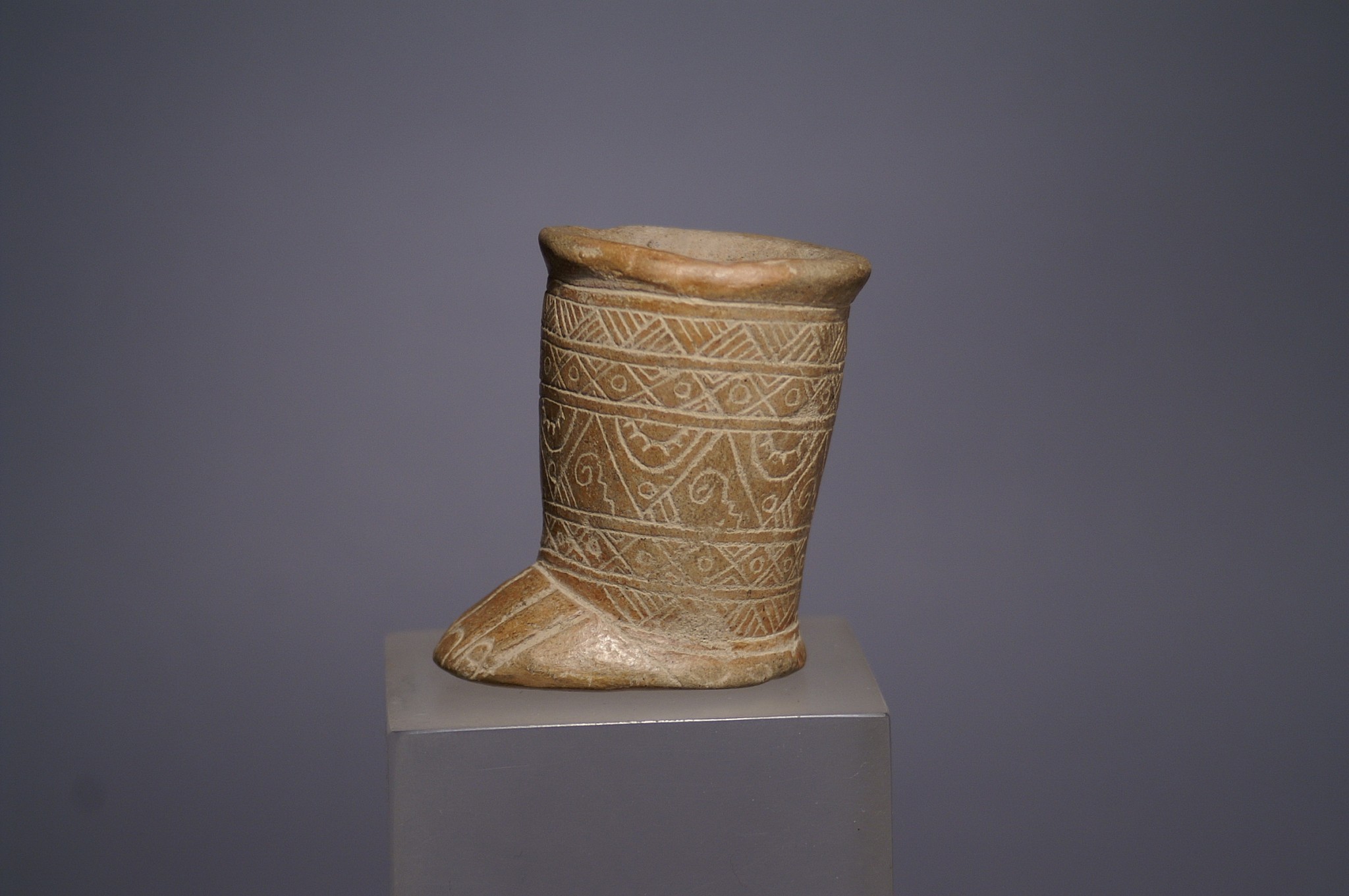




Ecuador, Monteno incised ceramic container in the form of a foot with suspension hole
This is typical of a lime container from the Monteno region and decorated with 4 bands of geometric designs. A similar votive foot vessel is illustrated in Amerindian Signs item 141
Period: Ecuador, Monteno North Coast, circa AD700-1534
Media: Ceramic
Dimensions: Height 2 3/4"
$950
N1049
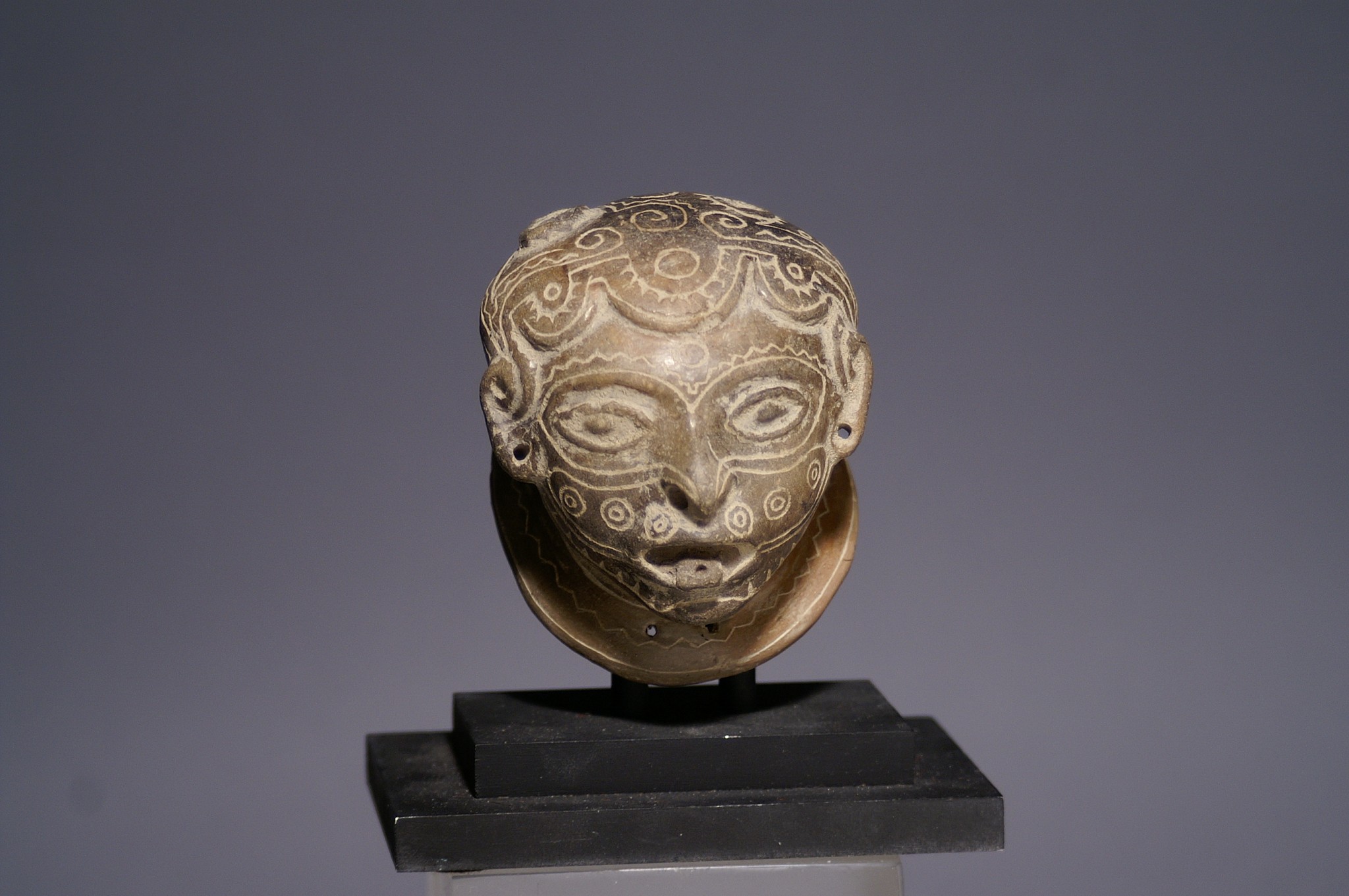




Ecuador, Monteno incised ceramic container in the form of a head with tattoos all over
This is typical of a lime container from the Monteno region and decorated with 4 bands of geometric designs. A similar votive foot vessel is illustrated in Amerindian Signs item 141
Period: Ecuador, Monteno North Coast, circa AD700-1534
Media: Ceramic
Dimensions: Height 2 3/4"
$1,100
N1050

Ecuador, Pair of Jamacoaque Monkey Maskettes
These small monkey masks were decorated with post-fire pigments in blue, green, and white over a gray slip, and were probably headdress adornments for a larger ceramic effigy figure. The artisan clearly intended these masks to depict howler spider monkeys (Ateles paniscus), the largest primates in the New World. These monkeys prefer the branches of the upper forest canopy, where they feast on ripe fruit supplemented by leaves and insects. In the Amazonian mythology monkeys are associated with creator deities and cultural heroes who bestowed gifts of abundance. Monkeys were understood by ancient Andeans to be older spirits reincarnated from a mythical period prior to the presence of human beings on earth. For further reading on the legends of tropical peoples see Klein and Cevallos’ "Ecuador: The Secret Art of Pre-Columbian Ecuador," 2007, page 25.
Period: Ecuador, Jama Coaque, Northern Manabi Region, 500 BC - AD 500
Media: Ceramic
Dimensions: Height: 3" to 4"
Price Upon Request
M7102AB
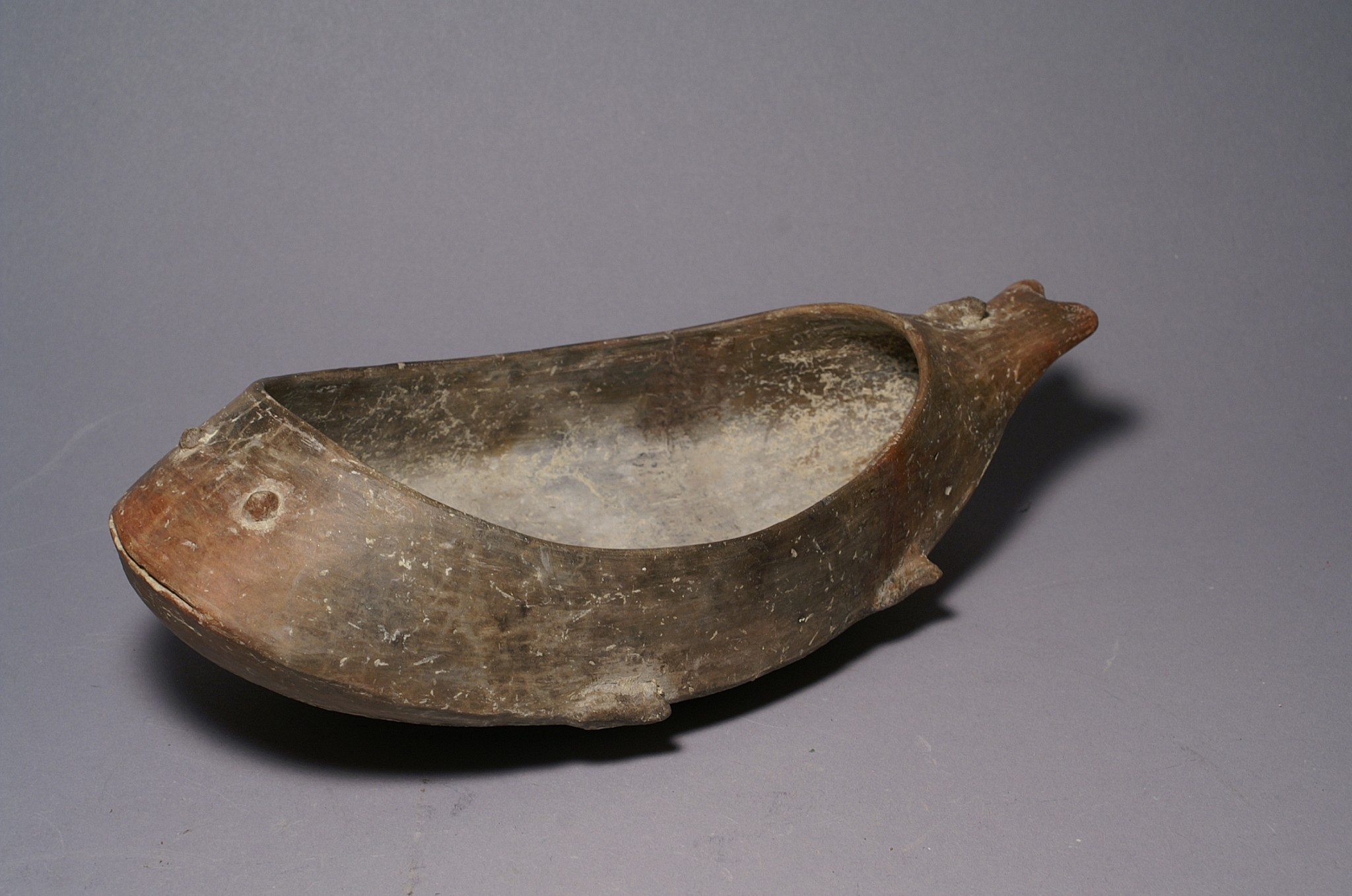





Ecuador, Pompano Fish Bowl
This is an early example of Chorrera ceramics, depicting a Pompano. Pompano are found in warm waters along the Pacific and Atlantic; they appear in larger numbers during El Niño currents. Illustrated in OCEAN FISHING IN PRECOLUMBIAN CHILE AND PERU.
Period: Ecuador, Choerra, Manabi circa 3000 BC
Media: Ceramic
Dimensions: Length: 9 3/4" inches
Condition: All parts original.
$3,250
M7154


